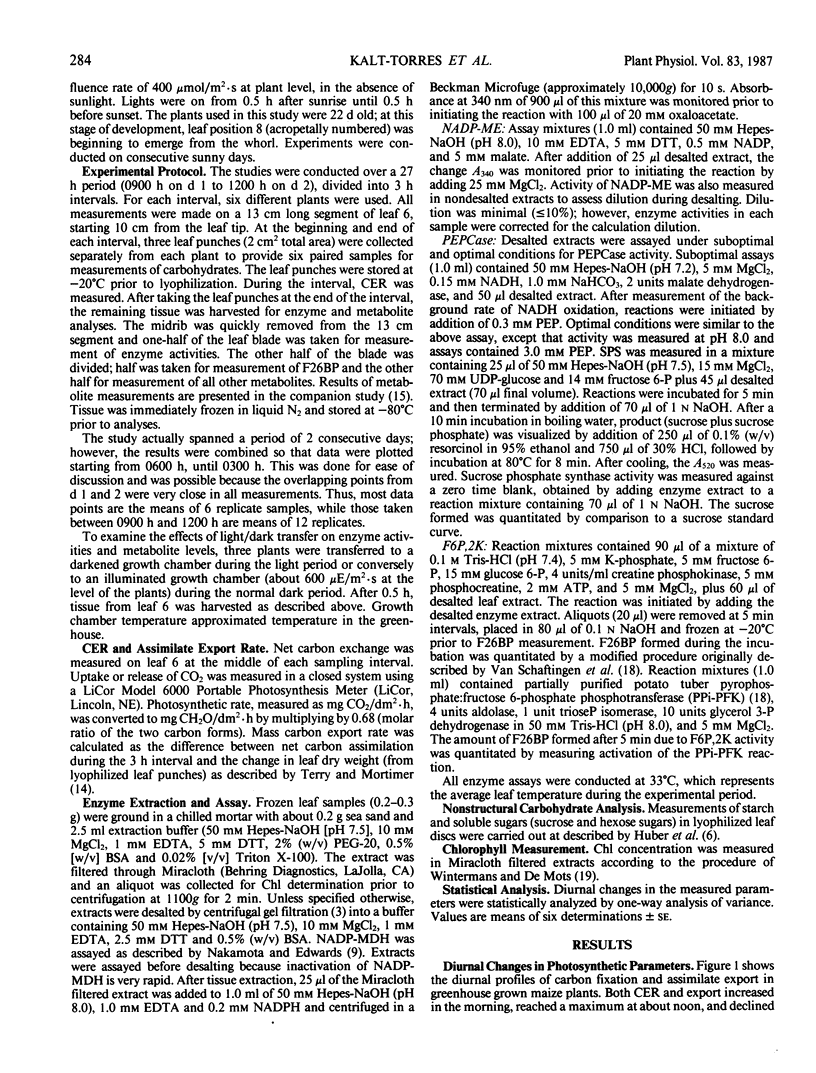Abstract
Diurnal changes in photosynthetic parameters and enzyme activities were characterized in greenhouse grown maize plants (Zea mays L. cv Pioneer 3184). Rates of net photosynthesis and assimilate export were highest at midday, coincident with maximum irradiance. During the day, assimilate export accounted for about 80% of net carbon fixation, and the maximum export rate (35 milligrams CH2O per square decimeter per hour) was substantially higher than the relatively constant rate maintained through the night (5 milligrams CH2O per square decimeter per hour). Activities of sucrose phosphate synthase and NADP-malate dehydrogenase showed pronounced diurnal fluctuations; maximum enzyme activities were generally coincident with highest light intensity. Reciprocal light/dark transfers of plants throughout the diurnal cycle revealed that both enzymes were deactivated by 30 minutes of darkness during the day, and they could both be substantially activated by 30 minutes of illumination at night. During 24 hours of extended darkness, sucrose phosphate synthase activity declined progressively to an almost undetectable level, but was activated after 1.5 hours of illumination. Thus, the diurnal fluctuation in maize sucrose phosphate synthase can be explained by some form of light modulation of enzyme activity and is not due to an endogenous rhythm in activity. No diurnal fluctuations were observed in the activities of NADP-malic enzyme or fructose 6-phosphate-2-kinase. Phosphoenolpyruvate carboxylase was activated by light to some extent (about 50%) when activity was measured under suboptimal conditions in vitro. The results suggested that the rates of sucrose formation and assimilate export were closely aligned with the rate of carbon fixation and the activation state of sucrose phosphate synthase.
Full text
PDF





Selected References
These references are in PubMed. This may not be the complete list of references from this article.
- Helmerhorst E., Stokes G. B. Microcentrifuge desalting: a rapid, quantitative method for desalting small amounts of protein. Anal Biochem. 1980 May 1;104(1):130–135. doi: 10.1016/0003-2697(80)90287-0. [DOI] [PubMed] [Google Scholar]
- Huber S. C., Rufty T. W., Kerr P. S. Effect of Photoperiod on Photosynthate Partitioning and Diurnal Rhythms in Sucrose Phosphate Synthase Activity in Leaves of Soybean (Glycine max L. [Merr.]) and Tobacco (Nicotiana tabacum L.). Plant Physiol. 1984 Aug;75(4):1080–1084. doi: 10.1104/pp.75.4.1080. [DOI] [PMC free article] [PubMed] [Google Scholar]
- Karabourniotis G., Manetas Y., Gavalas N. A. Detecting Photoactivation of Phosphoenolpyruvate Carboxylase in C(4) Plants : An Effect of pH. Plant Physiol. 1985 Feb;77(2):300–302. doi: 10.1104/pp.77.2.300. [DOI] [PMC free article] [PubMed] [Google Scholar]
- Rufty T. W., Kerr P. S., Huber S. C. Characterization of diurnal changes in activities of enzymes involved in sucrose biosynthesis. Plant Physiol. 1983 Oct;73(2):428–433. doi: 10.1104/pp.73.2.428. [DOI] [PMC free article] [PubMed] [Google Scholar]
- Sicher R. C., Kremer D. F. Changes of Sucrose-Phosphate Synthase Activity in Barley Primary Leaves during Light/Dark Transitions. Plant Physiol. 1984 Dec;76(4):910–912. doi: 10.1104/pp.76.4.910. [DOI] [PMC free article] [PubMed] [Google Scholar]
- Sicher R. C., Kremer D. F. Possible control of maize leaf sucrose-phosphate synthase activity by light modulation. Plant Physiol. 1985 Nov;79(3):695–698. doi: 10.1104/pp.79.3.695. [DOI] [PMC free article] [PubMed] [Google Scholar]
- Soll J., Wötzel C., Buchanan B. B. Enzyme regulation in c(4) photosynthesis : identification and localization of activities catalyzing the synthesis and hydrolysis of fructose-2,6-bisphosphate in corn leaves. Plant Physiol. 1985 Apr;77(4):999–1003. doi: 10.1104/pp.77.4.999. [DOI] [PMC free article] [PubMed] [Google Scholar]
- Usuda H., Edwards G. E. Localization of glycerate kinase and some enzymes for sucrose synthesis in c(3) and c(4) plants. Plant Physiol. 1980 May;65(5):1017–1022. doi: 10.1104/pp.65.5.1017. [DOI] [PMC free article] [PubMed] [Google Scholar]
- Usuda H., Kalt-Torres W., Kerr P. S., Huber S. C. Diurnal Changes in Maize Leaf Photosynthesis : II. Levels of Metabolic Intermediates of Sucrose Synthesis and the Regulatory Metabolite Fructose 2,6-Bisphosphate. Plant Physiol. 1987 Feb;83(2):289–293. doi: 10.1104/pp.83.2.289. [DOI] [PMC free article] [PubMed] [Google Scholar]
- Van Schaftingen E., Lederer B., Bartrons R., Hers H. G. A kinetic study of pyrophosphate: fructose-6-phosphate phosphotransferase from potato tubers. Application to a microassay of fructose 2,6-bisphosphate. Eur J Biochem. 1982 Dec;129(1):191–195. doi: 10.1111/j.1432-1033.1982.tb07039.x. [DOI] [PubMed] [Google Scholar]
- Wintermans J. F., de Mots A. Spectrophotometric characteristics of chlorophylls a and b and their pheophytins in ethanol. Biochim Biophys Acta. 1965 Nov 29;109(2):448–453. doi: 10.1016/0926-6585(65)90170-6. [DOI] [PubMed] [Google Scholar]


